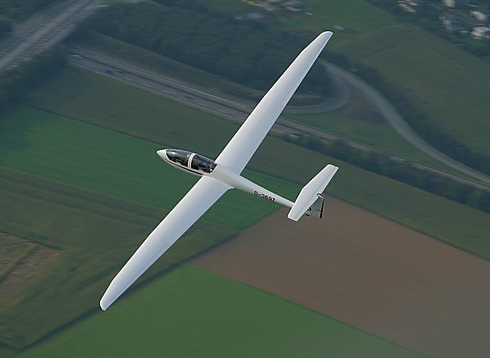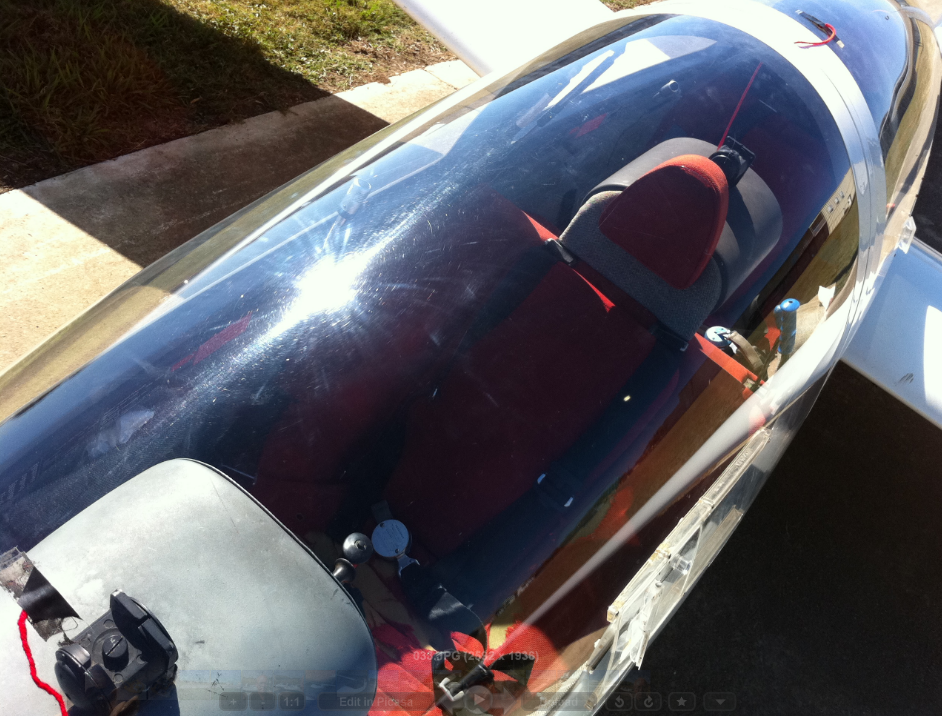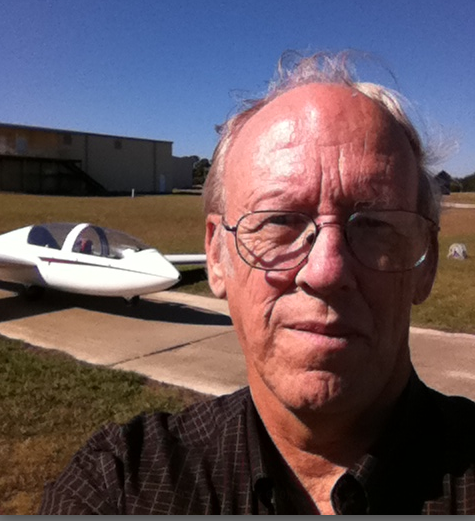Now, how could anyone hate string. Well, I do! Actually, I do not hate all string, just a particular piece of red string about a foot long. This chunk of string was taped to the windshield of a vehicle I was in this morning. As the vehicle moved, the string blew in a straight line from where it was taped back along the windshield, and it gave you a good idea which way the wind was blowing across the vehicle. With me so far?
If you think about it, the string should always sit there blowing straight up along the windshield as you move along. That is, as long as you go in a straight line. If you go around a turn, the string might slide to one side or another, but that would be OK, let it fly!
Actually, that is exactly what my stoopid chunk of string and I did – FLY!
The string was taped to the windscreen of a Grob 103B glider!

I was flying this glider this morning, or should I say, I was trying to fly this glider this morning! But, the string kept telling me I was not doing so very well. In order to understand why, you need to know something about how airplanes fly.
Basically, there are three controls a pilot needs to work with (four in most aircraft). Those controls deal with pitch (the elevators at the rear of the plane make the nose move up and down), roll (the ailerons on the tips of the wings cause the aircraft to roll – tipping the wing tips up on one side and down on the other), yaw (the rudders at the rear of the aircraft cause the nose to turn to the left or right) and speed (throttle control in a powered airplane). Once you understand what each control does, the pilot’s job is to keep the craft flying “smoothly” as it moves about in the sky. Pilots learn about something called “coordination” early in their career. A smooth, coordinated turn is made by rolling the wings away from level with the low wing on the side you want to turn toward. You use the other controls to make the turn “smooth”.
Now, it is possible to make a plane turn by doing nothing but rolling the wings the right way or using the rudder alone, and making sure the nose stays reasonably level. But doing things this way causes the plane to “skid” around the corner or “fall” into the turn, and the pilot is thrown (slightly) away from the normal position sitting in the seat. (You feel this when your car goes around a corner and you want to slide across the seat – thank goodness for seat belts!) A proper turn also uses the rudder and the ailerons together, and that is where the string comes back into the story!
That dumb chunk of string is sitting there telling you what a lousy pilot you are! If you do a “coordinated turn” the string never moves away from straight back along the windscreen. If you skid around a turn, meaning you are not using the rudder and ailerons properly, the string swings wildly away from the straight path and flops over to one side. You need to work the rudders (which you do with your feet) to keep things proper and get the string back where it belongs! A lot of planes I have flown turn just fine with no rudder work at all. Not this Grob!
I was all over the sky trying to control that silly string! I could not keep that dumb thing straight to save my soul! I did fine keeping the wings where I wanted them, and keeping the nose up and down properly, I even managed to fly the glider approximately where it was supposed to go. But those dumb rudder pedals did what they wanted to do, not what I wanted them to do – the string told me so – so I got frustrated pretty quick.
So, we take a deep breath, and remember that I have not flown in many a year, and I have never flown a glider, so I concentrated on learning what this craft could do. Let’s go back to the beginning!
Dave White, down at Boerne Stage Airfield, west of San Antonio was in the back seat, and I was in the front. We are sitting on the end of the runway in the glider after going over all the controls and instruments on the panel in front of me. Sitting on the runway ahead of us was an overpowered two-place airplane just like the one I first soloed in back in 1973. Between us was a long chunk of rope (ropes are OK, just not strings!). Once we are all buttoned up in the glider, have our safety harnesses bucked up, all 5 belts worth, have the canopy (windshield with that durned chunk of string taped on) locked into place, and radio checked, we wagged the rudder to signal the tow plane that we were ready for flight!

The tow plane moved forward until the rope pulled tight and the glider started to move, then he advanced the throttle and we started charging down the runway. The string was straight as an arrow! In almost no time at all, the glider lifted off of the runway, and we had to keep it low so we would not climb above the tow plane, Once he lifted off, our job was to keep the glider right behind the tow plane. Easier said than done! There goes that durned string. Moving everywhere. That is it moved everywhere when I tried to fly the glider. When Dave took the controls, the string locked back into place like it was glued there. Let me take the controls, and the glider hardly paid any attention to my efforts to control it at all. I was never unsafe, but I was not precise in anything I tried to do. And the string laughed at me the whole time.

Eventually, we worked our way up to about 3000 feet above the airfield, and the most memorable moment of all occurred. I pulled on a handle the releases the rope from the front of the glider, and we are off on our own. No motor, no sound, just gravity, updrafts of air, and a few birds to keep us company as we began “soaring” through the sky. To say it is different from any flying I have ever done is an understatement. Normally, in a light plane with no motor running, the pilot’s attention is totally on where you are going to land, and that will happen soon. In the glider, landing will happen eventually, but those huge long wings can pick up the slightest current of rising air, and a skilled pilot (like Dave) can make the glider rise up and up and you can actually fly for hours on a good day with no motor at all.
Today was nothing special in terms of rising air, but we did manage to climb up several hundred feet. The glider is amazingly efficient at flying. It goes about 40 feet forward for every foot it loses in normal conditions. (The space shuttle loses about 40 feet for every 40 feet it moves forward – not much better than a brick!). From our 3000 foot starting point, we could glide 120000 feet forward (about 22 miles – yikes!) So, we had time to enjoy the sunny day and sight-see. Look! Off to the right is George Strait’s ranch with his roping arena, off the other wing is downtown San Antonio. See that Boeing 737 over there? That is a Southwest airliner landing at San Antonio! See that bird up there? He is riding the up draft better than we are, let’s join him in that thermal!
All too soon, Dave says we need to see what this glider can really do. So, we do a tight turn (3-g’s, three times the pull of gravity) and it feels like we are spinning on the tip of the wing. (Is that a cow down there?). Next he has me do a few stalls – I pull the nose up and hold it until the glider slows down to where it cannot fly any more (about 38 MPH), the nose falls toward the ground as the wing stops lifting the craft. I release the controls, and we are quickly back to level flight again. (This always made me nervous when I first learned how to fly. Now it is kind of fun!) Next, we do a few roller-coaster rides, pushing the nose down to pick up speed, then pulling back to climb and pushing the nose over to generate negative g’s. Everything that is not bolted down (like us) heads for the ceiling of the plane during this one. (I wondered where than pen went. Now it is on the canopy where I can reach it!)
Finally, we head back to the airport (we have been at this about 45 minutes!) We make a down-wind landing, This is opposite of what pilots normally do. We land with the wind. Dave wants me to see how much power the wings actually have. We touch down moving pretty fast at the far end of the runway, once he has the plane fully on the ground, he pulls back on the controls, and off we go back up into the sky. Now he pulls out something called “spoilers” on the wings – kind of like holding your hand straight out from a car window. Feel that pressure on your hand? That is slowing the car down (OK, not much). On the glider, these things significantly reduce the lift from the wings and really slow the glider down. This time we touch down for good, and roll to a stop right back where we started.
That durned string is still there – grinning at me (if string could grin!) I will master that silly string yet!

See that string at the lower left corner. I hate that string. Oh look! Dave had one he could see as well! It is at the top right! I probably hate that one as well!
Gliding is something I have always wanted to do. It is the purest form of flight – you learn to become one with the plane and with the air around you. You learn to feel the rising air, and learn how to fly with it as it blows across the ground. I fully feel that learning how to fly something like this Grob, will make me a better pilot. Since I have been away from flying for so long, this sounds like a great way to get back into flying. Dave says I did pretty well when all was said and done. It sure did not feel that way, but gliders really make you fly. You are the pilot, not just a passenger who occasionally makes the plane turn a bit. Mastering a glider marks you as a true pilot – something I pan to do!

OK, I had a bad hair day! Hey – I still have hair to have a bad day with. Count my blessings, I guess! Any day flying beats all other days! (So says the pilot in me.) Go learn to fly like a bird – in a glider! And may you beat that silly string!
Comments
There are no comments yet.